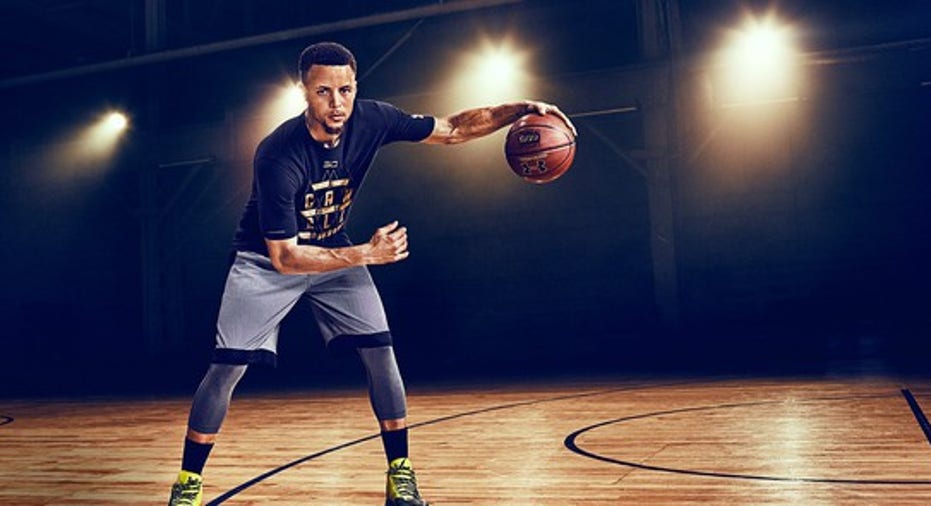4 Red Flags in Under Armour Inc's Income Statement

Under Armour (NYSE: UA) stock has fallen nearly 20% over the past 12 months due to slowing sales, rising expenses, and tougher competition. To understand these challenges, investors should examine UA's second quarter income statement -- which features four redflags indicating that its high-growth days might be over.
Image source: Under Armour.
1. Slowing sales growth
Under Armour's revenue grew 28% annually during the quarter to $1 billion, merely matching analyst estimates and ending the company's streak ofeight consecutive top line beats. It also represented a slowdown from 30% growth in the first quarter and 29% growth in the prior year quarter.
The company attributes much of that decline to the bankruptcy of retailer Sports Authority. But the chain's failure -- along with shaky reports from Nike (NYSE: NKE), Skechers,and VF Corp -- indicate that demand for athletic apparel and shoes is weakening.
Analysts expect Under Armour's revenue torise 21% in the third quarter, 22% in the fourth quarter, and 24% for the full year. That also represents a slowdown from 28% growth in 2015 and 32% growth in2014.
Source:YCharts
2. Growing dependence on footwear
A major challenge for Under Armour is its growing dependence on footwear. In the first half of 2016, its footwear revenues rose 61% annually and accounted for 25% of the company's sales -- up from 20% in the first half of 2015. Apparel sales rose 20% to 62% of revenue, compared to 67% of revenue a year earlier.
This means that the company is becoming more exposed to the saturated market of athletic footwear, which is dominated by deeplyentrenched players like Nike. Back in March, Morgan Stanley reported that Under Armour shoes experienced a 23% price decline in less than two years, compared to a mere4% decline across the industry. Higher sales of lower-margin footwear, outlet, andinternational products notably caused its gross margin to contract 70 basis points annually to 47.7% last quarter.
To challenge Nike's high-end LeBron James, Kevin Durant, and Jordan shoes, Under Armour inked its own pricey deals withSteph Curry, Cam Newton, Tom Brady, and other high-profile athletes. But as the company recently discovered with the new Curry 2's poor reception acrosssocial media, high profile endorsements can't make up for lackluster shoe designs.
Image source: Under Armour.
3. Rising expenses
The company's high profile deals, along with higher marketing expenses and a $23 million impairment charge from the Sports Authority bankruptcy, caused its selling, general, andadministrativeexpenses to rise 32% annually to $458million last quarter.
That big increase reduced the company's operating margin from 4.1% in the prior year quarter to just 1.9%, while net profit margin dropped from 1.9% to 0.6%. Under Armour's margins vary widely throughout each year, but its second quarter margins represent multi-year lows for the company.
Source:YCharts
4. A wasteful $59 million charge
Theathletics wearcompany's net profit margin was positive at the end of the second quarter, but it still ended the quarter witha net loss of $52.7 million due to a $59 million charge caused by a class action lawsuit.
Under Armour previously had two classes of shares -- Class A for regular shareholders and Class B for CEO Kevin Plank. However, it issued new non-voting Class C shares as a one-for-one "dividend" to Class A and B shareholders earlier this year. That move angered some investors, who filed a lawsuit against the company claiming that the split diluted existing shares to protect Plank's control of the company.
To appease those investors and offset the dilution, it paid a one-time special dividend of $59 million to Class C shareholders, which was written off as a loss against all three share classes. The entire ordeal didn't meaningfully boost shareholder value, since the dividend just offset the dilution, but it caused a quarterly loss.
Looking beyond the income statement...
Under Armour's income statement reveals a lot of potential problems with the company, but the red flags don't end there. The balance sheet reveals that inventories increased 30% annually last quarter, cash and equivalents fell 20%, and long-term debt rose 25%.
Moreover, Under Armour stock still trades at 50 times forward earnings -- which is much higher than Nike's forward P/E of 20. Therefore, investors should carefully examine all these red flags before before buying Under Armour stock.
A secret billion-dollar stock opportunity The world's biggest tech company forgot to show you something, but a few Wall Street analysts and the Fool didn't miss a beat: There's a small company that's powering their brand-new gadgets and the coming revolution in technology. And we think its stock price has nearly unlimited room to run for early in-the-know investors! To be one of them, just click here.
Leo Sun has no position in any stocks mentioned. The Motley Fool owns shares of and recommends Nike, Skechers, and Under Armour (A Shares). Try any of our Foolish newsletter services free for 30 days. We Fools may not all hold the same opinions, but we all believe that considering a diverse range of insights makes us better investors. The Motley Fool has a disclosure policy.